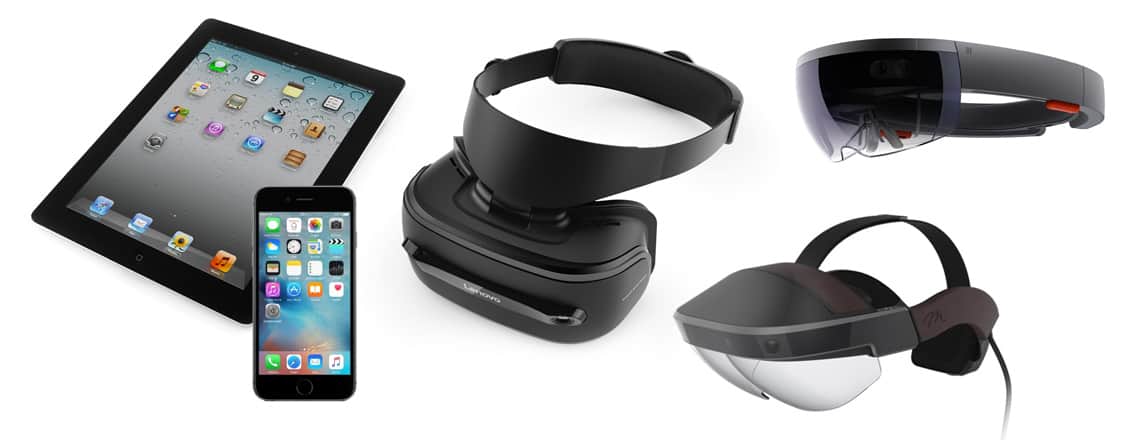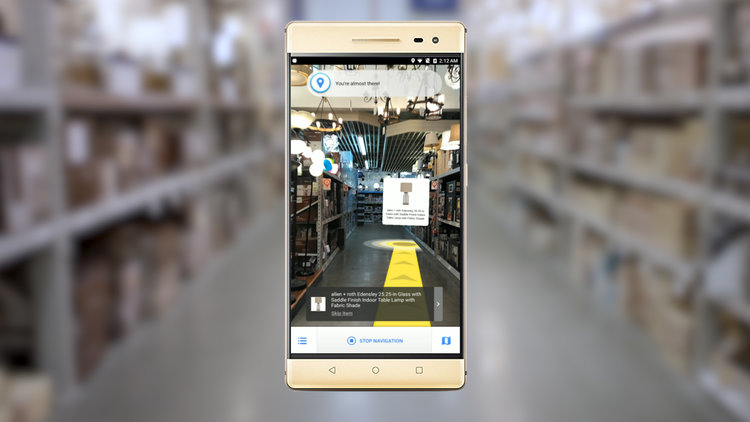THIẾT BỊ AR / MR

AR/MR Devices
In order to use Augmented Reality (AR) and Mixed Reality (MR) applications, terminal devices with a complex composition of Hardware modules are necessary (Smartdevices). Historically seen, Smartphones have been the first mobile terminal devices to use AR, especially the Apple iPhone 3GS. Later on Tablets, such as Android based devices by Samsung (Samsung Galaxy Tab) or Apple’s iOS based iPad, followed it. In 2012, Google promoted its project “Google Glass” and even though it hasn’t been the only present smart glass representative, it has won the most attention due to its marketing and feature set. Since 2017 Smart Glasses (among others the remake of the Google Glass) and AR Headsets (e.g. HoloLens, Meta2, Magic Leap) have come to the attention of the pace gaining developer scene due to their more complex technologies and extensive sensors. After the publication of new fundamental AR technologies by Apple (ARKit) and Google (ARCore) as part of their representative operating system, the development of AR optimized hardware by both companies (Smartphones, Tablets, Smart Glasses or even more complex Headsets) is getting more and more realistic (Q1 2017).
In the following, different smart devices are listed. Applications can (of course) be used cross plattform or can be streamed live on big screens and/or recorded on video (e.g. for fairs or other forms of presentation).
Smartphones and Tablets

Smartphone in use with AR App
Video Player
Smartphone and Tablet in use with AR App
Advantages
- Wide spread among end users
- Always present with end users
- Typical platform to spread apps that are used on dayly basis
- Tablets (compared to Smartphones) have even more computing power and generally speaking a larger display
Overview
Smartphones and tablets are usually comprehensive in their producers featured with similar/comparable hardware components and have been used as platforms for AR-Apps for a long time, due to the wide spreading among the end user market. In addition to the ordinary smartphones and tablets, special solutions exist that have not yet arrived to the mainstream and contain additional hardware modules especially made for AR applications in contrast to the widely spread models.
Examples of Generalized Smartphones/Tablets

Type: Smartphone
Device: iPhone
Producer: Apple
Operating System: iOS

Type: Smartphone
Device: Galaxy S Serie
Producer: Samsung
Operating System: Android

Type: Smartphone
Device: P-Serie
Producer: Huawai
Operating System: Android

Type: Tablet
Device: iPad
Producer: Apple
Operating System: iOS

Type: Tablet
Device: Galaxy Tab Serie
Producer: Samsung
Operating System: Android

Type: Tablet
Device: Media T3 10
Producer: Huawei
Operating System: Android
Examples of Smartphones/Tablets with AR optimized components
Video Player
Type: Phablet
Device: Phab 2 Pro
Producer: Lenovo
Operating System: Android
Additional Components: Google Tango Technology (advanced computer vision, image processing, special vision sensors)
Comment: Tango has been stopped in August 2017
Video Player
Type: Smartphone
Device: ZenFone AR
Producer: Asus
Operating System: Android
Additional Components: Google Tango Technology (advanced computer vision, image processing, special vision sensors)
Comment: Tango has been stopped in August 2017
Smart Glasses and Headsets

Picture showing Microsoft HoloLens, used with permission from Microsoft
Video Player
00:00
06:44
Video showing Microsoft HoloLens, used with permission from Microsoft
Advantages
- Especially made hardware profiles for MR and AR application branches
- Hands free interaction via gesture and voice recognition
- AR optimized hardware enables more complex AR software solutions (e.g. orientation in a room without image markers known as “inside-out-tracking“, etc.)
- Intuitive perception of the augmented reality via super imposed vision in the own field of view
Overview
Smartglasses exist in various kinds of application with different request profiles and therefore also different hardware configurations. AR optimized Smart Glasses usually not only contain their own processor and the corresponding energy supply, but also complex hardware and software modules to recognize and analyse the real environment and the possibility of play visual and auditory data of digitally added impressions of the reality (looking through the glasses, the user can see the real environment together with virtual additions).
Examples of AR Smartglasses / Data Goggles
Video Player
00:00
02:01
Type: AR-Headset
Device: HoloLens
Producer: Microsoft
Operating System: Windows
Status: Available
Video Player
00:00
04:03
Type: AR-Headset
Device: Meta 2
Producer: Meta
Operating System: Custom OS
Status: Available
Video Player
00:00
02:03
Type: AR-Smartglasses
Device: R7, R8 and R9 Series
Producer: ODG (Osterhoutgroup)
Operating System: Recticle OS based on Android
Status: R7 available
Video Player
00:00
00:00
Type: AR-Headset
Device: DAQRI Smart Glasses
Producer: DAQRI
Operating System: DAQRI Visual Operating System™ (VOS)
Status: Available
Video Player
00:00
04:07
Type: AR-Smartglass
Device: Atheer AiR Glasses
Producer: Atheer
Operating System: Android
Status: Available
Examples of basic Data Googles
Video Player
00:00
01:08
Type: Data Goggle
Device: Google Glass Enterprise
Producer: Google
Operating System: Android
Status: Pre-Release
Video Player
00:00
00:00
Type: Data Goggle
Device: Monitorless
Producer: Samsung
Operating System: Custom OS
Status: Prototyp
Video Player
00:00
02:22
Type: Data Goggle
Device: Vuzix M 300
Producer: Vuzix
Operating System: Android
Status: Available
Video Player
00:00
00:29
Type: Data Goggle
Device: Spectacles
Producer: Snap
Operating System: Custom App
Status: Available
Kiosk Systems / AR-Installations

AR Kiosk System – Productkonfiguration and virtual product preview
Video Player
00:00
02:40
AR Installation with Facetracking made by Panasonic
Advantages
- AR-Kiosk can be visually and functionally integrated into fair or sale appearances or at the POS
- The variety of possible elements and flexible configurations of the hardware and sensors enables made-to-measure AR-Solutions
- Users have low entrance barriers and do not have to carry around their own smartphone or download an app
- The quality of the graphic elements and the virtual additions via great computing power is often better than at mobile AR
Overview
Kiosk-Systems and interactive AR-Installations have already established before the spreading of smartphones and mobile AR solutions for events, fairs and at the Point-of-Sale (POS), and are usually based on the “Magical Mirror” principle. Solutions in this field can be realised on a basis of All-in-One devices (mostly large Android Tablets) or computer and laptop components. Laptops have more computing power and can be combined with various hardware and sensors (e.g. Kinect). Those solutions offer flexible configurations and replace the smartphone at the place of service.




